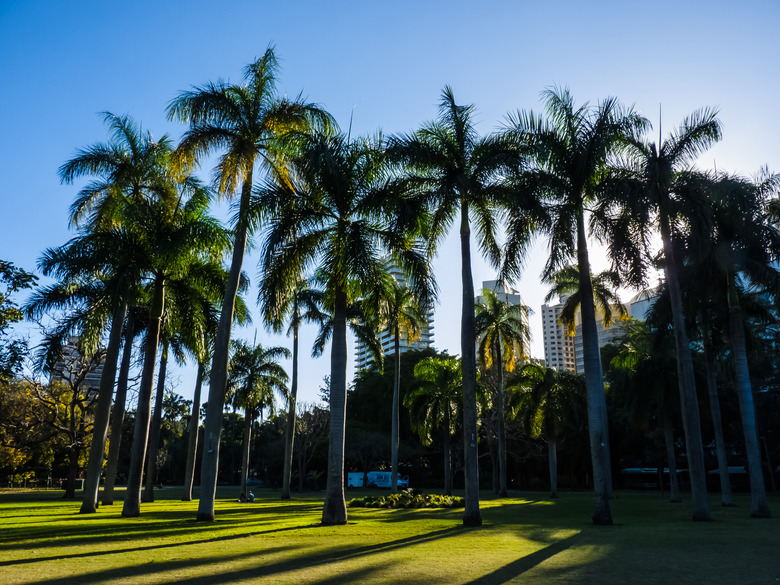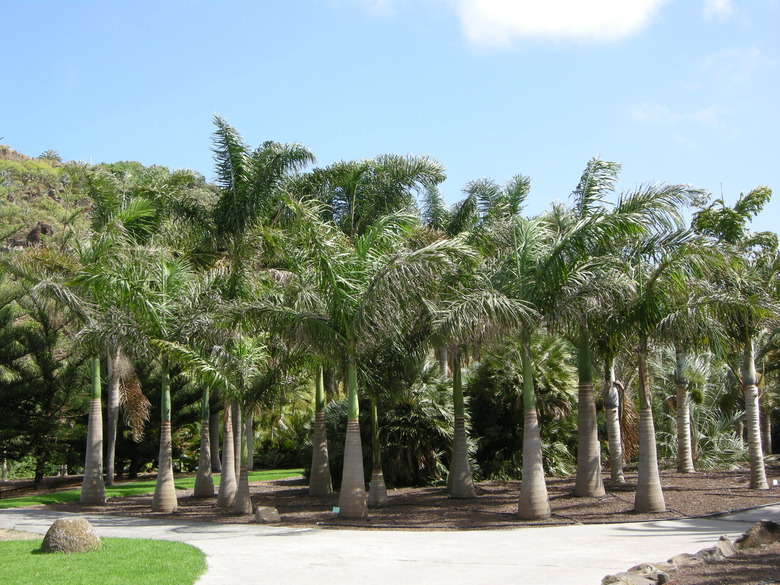How To Grow Royal Palm Trees
An enormous specimen palm tree, the royal palm is native to Cuba, Mexico and South Florida. It has naturalized in the U.S. in Hawaii.
The royal palm (Roystonea regia, USDA hardiness zones 10 to 11) **reaches 50 to 70 feet high, spreading as much as 25 feet,** so plant this beautiful tree only if you know you have room for it; otherwise, enjoy it in public spaces like parks or city streets, where it is usually planted.
About the Royal Palm Tree
There are 10 different species called "royal palm," most of them native to the Caribbean. R. regia is the most common species grown in the U.S., in particular Hawaii, but there is also another well-known royal palm, the Caribbean royal palm (Roystonea oleracea), and both of these species now grow in the wild in Hawaii. The leaves of R. regia have a more upright form, while R. oleracea's fronds are more feather-shaped.
The royal palm tree is fast-growing, with a growth rate of about 24 inches per year. These trees are self-cleaning, which means that dead and dying leaves drop off of their own accord, usually about one leaf per month.
While this sounds like a great thing and makes maintenance easier, these leaves are huge—10 to 15 feet long—and weigh about 50 lbs. when fresh, so they can injure people and property when they suddenly drop from 70 feet up.
The R. regia royal palm is also known by the common names Cuban royal palm and Florida royal palm; its scientific name is sometimes also assigned to a different species, Roystonea elata, and even to a different genus, Oreodoxa regia.
Planting and Basic Care
**Location:** Choose a full-sun or partial-shade location where your tree can be 10 feet from structures or vegetation.
**Watering:** While the soil can be either loamy or sandy, these trees have heavy water requirements, so the sandier the soil, the more frequently you need to irrigate. The royal palm tree needs little care, but don't let it dry out when it is still young.
**Soil pH:** Furthermore, royal palms are not fussy about soil pH, which can be slightly alkaline or slightly acidic. Avoid too-alkaline soils, however, as this can contribute to an iron deficiency.
**Maintenance:** You may decide to remove the browning leaves before they fall off if the tree is located in an area where these very heavy leaves could damage other vegetation, property or people.
Nutrient Deficiencies, Diseases and Pests
The royal palm is susceptible to some nutrient deficiencies, fungal diseases and pests, which may require regular fertilization with a product that includes the micronutrients the palm is missing..
Lack of Nutrients
Three primary nutrient deficiencies plague royal palms: potassium, manganese and boron, evidenced by these symptoms:
- **Potassium deficiency:** The tips of the leaves begin to turn brown; then the entire leaf browns, especially on the oldest, most mature leaves, and dies. They may fall prematurely. The trunk may also begin to taper toward the top.
- **Manganese deficiency:** Similar to symptoms of potassium deficiency, manganese deficiency first causes the tips of the leaves to brown and curl, but the damage usually occurs on new, young leaves rather than mature ones.
- **Boron deficiency:** If new, young, emerging leaves become distorted or stunted, the palm may have a boron deficiency. When severe, the entire crown of the tree may bend over and grow sideways.
Any of these deficiencies can kill a royal palm. Manage them using a slow-release fertilizer of the formulation 8-2-12-4 Mg or 8-0-12-4 Mg, where the first three numbers equate to nitrogen, phosphorus and potassium, while the fourth number is magnesium (Mg).
For a lack of manganese, add a soil application of manganese sulfate or spray it directly on the foliage for quicker results. For a boron deficiency, apply slow-release boron.
In all cases, read the product instructions and, ideally, consult a professional landscaper to make sure that the deficiency is correctly identified and that the amounts of fertilizer you are applying are appropriate.
Tip
For a lack of manganese, add a soil application of manganese sulfate or spray it directly on the foliage for quicker results. For a boron deficiency, apply slow-release boron.
Fungal Diseases
Two serious fungal diseases can affect a royal palm, rotting the trunk: Ganoderma butt rot and Thielaviopsis trunk rot. Ganoderma butt rot affects the bottom 3 feet, while Thielaviopsis trunk rot invades the tree through a wound in its upper trunk.
If the disease is severe, the xylem of the tree, through which water is conducted, is affected, and you'll begin to see dead and dying leaves.
In butt rot, a severely diseased tree produces a conk, which is a reddish-brown growth with a white edge at the base or coming out of the trunk. Once a conk is observed, the tree will not recover, so the only option is to remove the tree to avoid spreading the disease.
In trunk rot, you may observe no symptoms, and the tree may appear healthy aside from some stem bleeding until it collapses or the canopy falls off. This is quite a dramatic occurrence! Fortunately, this condition is somewhat uncommon. It cannot be reversed.
Insect Pests
The primary pest that might target your royal palm is aptly named: the royal palm bug (Xylastodoris luteolus). The leaf damage is similar to potassium or manganese problems, but these bugs tend to attack the mid-canopy leaves rather than those that are very young or very mature.
If the leaves on the tree are low enough for you to look at them, you may see brown streaks or the bugs themselves, which are small, green and oval.
No residential chemical is recommended for home use. Instead, encourage natural predators such as spiders.
References
- Cal Poly UFEI: Royal Palm
- University of Florida IFAS Extension: Roystonea Regia – Royal Palm
- University of Florida IFAS Extension: Fertilization of Field-Grown and Landscape Palms in Florida
- University of Florida IFAS Extension: Royal Palm Bug, Xylastodoris Luteolus Barber (Insecta: Hemipetra: THaumastocoridea)
- University of Florida IFAS Extension: Ganoderma Butt Rot of Palms
- University of Florida IFAS Extension: Thielaviopsis Trunk Rot of Palm

